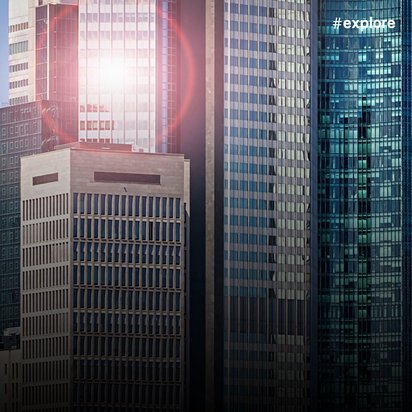Klimaschutz
Five ideas for more climate-friendly buildings
Water-cooled windows and wind power from the garden: how buildings can become more energy efficient.

Klimaschutz
Water-cooled windows and wind power from the garden: how buildings can become more energy efficient.

24 August 2022
The operation of buildings is worldwideresponsible for 30 per cent of energy consumption and 28 per cent of CO2 emissions. Installing insulated windows, insulating roofs and walls and switching to heat pumps help to save energy. And researchers around the world are working on further innovative ideas to improve the energy balance of buildings.
Climate change is driving up temperatures worldwide - and more and more people are using air conditioning to combat this. But these consume a lot of electricity. And as this still comes from fossil fuels in many places, air conditioning systems in turn fuel global warming. A vicious circle that a British researcher wants to break: with water-cooled windows. Today's insulating glass consists of several layers of glass. Matyas Gutai from Loughborough University wants to fill the spaces between the layers with water. The incident light initially heats the water instead of the space behind it. At a certain temperature, the water is pumped out and replaced with cooler water. The pumped-out water can then be used in the house as service water - for flushing the toilet, the washing machine or the plants in the garden, for example. A house with water-filled windows and a heat pump could consume up to 72 per cent less energy than a building with conventional heating and cooling systems, as the British researcher has calculated. Last but not least, the water windows are said to be good sound insulators. And unlike shutters and blinds, they do not obstruct the view on hot days.
In hot regions such as the Greek islands, white is the wall colour of choice. And of course this is not just for aesthetic reasons. After all, white reflects the sun's rays and thus ensures more tolerable temperatures indoors. According to US researchers, they have now developed the whitest wall colour to date. It is said to reflect more than 98 per cent of incident sunlight. As a result, its surface is 4.5 degrees below the ambient temperature, even in the midday heat, and as much as 10.5 degrees at night, according to the scientists' measurements. "If you were to use this paint to cover a roof area of a good 90 square metres, you could achieve an estimated cooling capacity of ten kilowatts," says Xiulin RuanProfessor of Mechanical Engineering at Purdue University in the US. "That's more powerful than the central air conditioning systems used in most homes." The ultra-white is said to be as resistant as conventional wall paint. And it should also benefit the environment. After all, if façades heat up less, this also works against urban heat islands, which residents of large cities are increasingly struggling with.
Insulation material is usually used primarily to keep the heat in the home. The material, which researchers at the the universities of Halle-Wittenberg and Leipzigare designed to store summer heat instead - to release it again at night or in winter. The invention is based on a so-called latent heat accumulator. This can absorb heat by changing its aggregate state from solid to liquid. When the material hardens, the stored heat is released again. A principle that is familiar from hand warming pads for the winter. If integrated into insulation boards, the new material could store up to 24 times more heat than conventional concrete or plaster, according to the researchers' calculations. So far, it is still being produced in small quantities in the laboratory - mainly from environmentally friendly materials. In the future, it could improve the energy balance of buildings on a larger scale and in both summer and winter. It could also be used as passive cooling to increase the efficiency of solar systems or battery systems.
This is an article from #explore. #explore is a digital journey of discovery into a world that is changing at a rapid pace. Increasing networking, innovative technologies and all-encompassing digitalisation are creating new things and turning the familiar upside down. But this also harbours dangers and risks: #explore shows a safe way through the networked world.